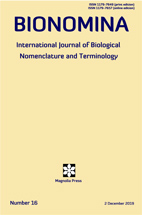Abstract
Starting from a finding concerning a few specific nomina proposed by Linnaeus (1758, 1760) and Linné (1766–1767) in herpetology, we returned to the ‘rules of nomenclature’ followed, more or less explicitly, in taxonomic works of the 18th century, in an attempt to understand the status of capitalised epithets. We conclude that such epithets were viewed by their authors as nouns in apposition, or more rarely as nouns in the genitive. Therefore, nowadays, they must be treated as invariable, and not as adjectives that should agree in grammatical gender with the generic substantives with which they are combined.
We provide a catalogue of these herpetological capitalised epithets in Linnaeus (1758, 1760) and Linné (1766–1767) with some nomenclatural consequences that result from our observations, especially for Corallus hortulana, Macrovipera lebetinus and Thamnophis saurita.
In order to solve some nomenclatural cases, we had to resort to 12 Articles of the Code (1.3.1, 3, 11.9.1.2, 11.9.1.3, 23.2, 23.9, 31.1, 31A, 31.2.2, 32.5.1, 33.3.1, 34.2.1, 58) and to 29 technical nomenclatural terms. One more time, this highlights the fact that nomenclatural problems concerning old nomina cannot be properly dealt with in a hurry and without a good, but also critical, knowledge of the Code, and that the use of a more detailed terminology than that of the Code facilitates such a work.

